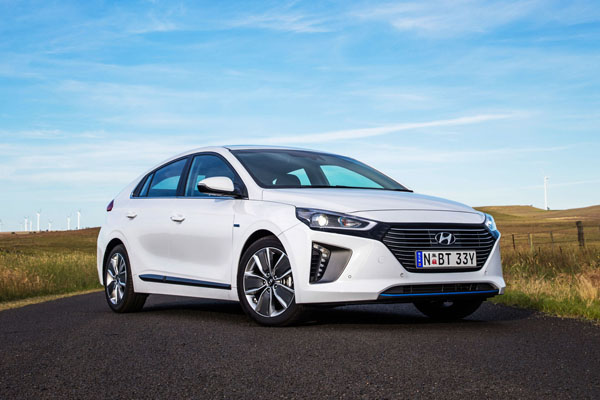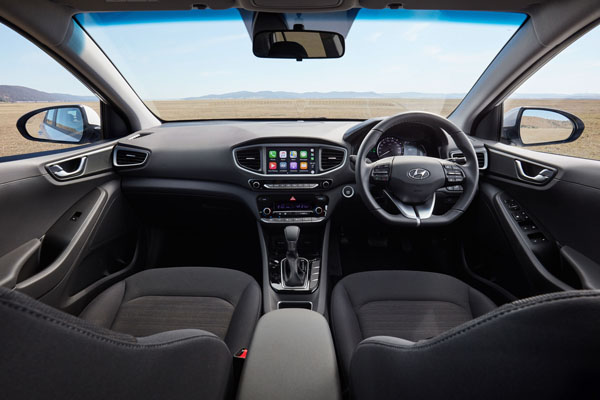 Hyundai has taken itself to the forefront of automotive battery technology with its Ioniq hatchback being the only vehicle to be offered in Australia with three different variations of electric power – petrol/electric hybrid, petrol/plug-in electric hybrid and fully electric.
Hyundai has taken itself to the forefront of automotive battery technology with its Ioniq hatchback being the only vehicle to be offered in Australia with three different variations of electric power – petrol/electric hybrid, petrol/plug-in electric hybrid and fully electric.
Although the name does have a Greek sound to it, Ioniq is actually a blend of ‘ion’ and ‘unique’. The word ion refers to an atom or molecule with a net electric charge while unique is one of the most misused words in the English language – but we won’t go into that here.
The entry level Ioniq Hybrid uses a conventional Pruis-type mixture of petrol/electric with its principal power source coming from a 1.6-litre four-cylinder direct-injection petrol engine of 77 kW combined with a 32 kW electric motor for a total power output of 109 kW.
The batteries are recharged through regenerative braking. Combined fuel usage is listed at 3.4 litres per 100 kilometres.
Ioniq Plug-In has the same engine as the Hybrid with combined output of 104 kW and 265 Nm. Like the Hybrid it uses regenerative braking to charge the batteries but can also the plugged into any external power point to provide around 63 km of electric-only travel.
While the primary power source of the Hybrid is the engine the Plug-In runs on the battery with the engine only kicking in when additional power or torque is required or when the battery has been flattened. Charging takes just over two hours. Fuel consumption is listed at a frugal 1.1 litres per 100 km.
Ioniq Electric relies entirely on battery power to produce its peak outputs of 88 kW and 295 Nm. With an approximate range of 250 km it falls well below the 400+ km range of the Hyundai Kona Electric SUV although an imminent upgrade will increase by about 20 per cent.
Like the Kona the level of the Ioniq Electric’s regenerative braking can be adjusted through steering-wheel mounted paddles.
All three models comes with the choice of Elite or Premium specification levels with pre-on road prices starting at $33,990 for the Hybrid Elite and topping out at $48,990 for the Electric Premium.
STYLING
Ioniq has a sleek fastback profile designed not just for its looks but also, with a drag co-efficient of 0.24, to enhance aerodynamic performance. The major difference in appearance between the three variants is at the front where the Electric which needs minimal airflow so doesn’t have a grille.
At the rear is an integrated spoiler that blends in seamlessly with the wide taillights. It looks great from the outside but does seriously affect rear visibility from inside.
The Premium models have a tilt-and-slide powered sunroof.
SAFETY
All Hyundai Ioniq models have achieved the maximum five-start ANCAP safety rating with seven airbags, front and rear-parking sensors and – given the restricted rear visibility – a very welcome rear view camera with dynamic guidelines.
Also standard is the Hyundai SmartSense safety package that includes smart cruise control; autonomous emergency braking with pedestrian detection; lane keep assist; blind spot monitoring; forward collision warning and rear cross-traffic alert.
The two outer rear seats come with IsoFix child seat restraint anchors.
INTERIOR
Adding to Ioniq’s green credentials much of the Ioniq’s interior has been crafted using a variety of eco-friendly materials including recycled plastic, powdered wood, volcanic stone and sugar cane by-products.
Elite models have cloth trim while Premium gets leather. All models have two 12-volt outlets at the bottom of the dashboard with Aux and USB sockets between them.
Storage areas include two cup holders in the centre console and bottle holders in all four doors.
The driver’s seat in the Elite is manually adjustable, the Premium’s is powered.
The second row is comfortable with enough room for two adults without too much of a squeeze. Rear legroom is reasonable although the Ioniq’s coupe-like roofline will make life uncomfortable for anyone approaching 1.8 metres in height. There’s a wide folding armrest with a pair of cup holders.
The Hybrid provides 456 litres of cargo space, expandable to 1518 litres with the 60:40 split rear seatbacks folded and loaded to the roof. Plug-In space drops to 341 / 1401 litres and Electric to 350 / 1410 litres.
INFOTAINMENT
Display is through an eight-inch split colour touch screen with excellent graphic quality and logical navigation. Likewise the separate heating, ventilation and air-conditioning controls are well-placed and easy to operate.
Satellite navigation with SUNA live traffic updates, Apple Car Play or Android Auto and DAB+ digital radio are all fitted as standard. An Infinity premium audio system with eight speakers and external amplifier provides good quality sound.
DRIVING
Our test car was the Ioniq Hybrid Premium. As is the norm with hybrids the car starts under electric power and can confuse the new adopter because, despite its silence, it’s ready to move off. Unless you’re slowly manoeuvring, around a car park for example, the engine will in almost immediately upon acceleration.
First impressions are good with access to the driver’s seat not needing an excessive amount of bending and the seat comfortable and supportive. Unfortunately the parking brake is of the old awkward foot-operated variety – why?
Once underway the Ioniq Hybrid is comfortable and easy to drive with the regenerative braking the only indication that you aren’t driving a conventional petrol car.
Two drive modes are available, Eco and Sport. Given that green was our colour of the week we spent most of the time in Eco mode earning ourselves an 80 per cent efficient driving rating.
Switching to Sport mode sharpened up the performance noticeably, with paddle shifts adding to the driving enjoyment.
Despite all our efforts we couldn’t match the Hybrid Premium’s listed fuel consumption of 3.9 litre per 100 kilometres, averaging around the mid 4s.
As with all Hyundais, Australian local engineers were involved in Ioniq’s suspension setup and the MacPherson strut / multi-link set-up coped well with the occasional pot-holes and patchy road surfaces.
SUMMING UP
While electric cars are no doubt the future the present clearly remains with hybrids both in terms of price and driving range.
Although the Ioniq Electric is between $10,000 and $11,000 dearer than the Hybrid the difference in range is much more significant. When we picked up our Hybrid in Sydney the range showed up at around 930 kilometres. We returned it a week later having travelled around 300 km with the range still showing 720 km.
By contrast the current Ioniq Electric has a range of only around 230 km although that is anticipated to increase to about 310 km when an upgraded version arrives in a few weeks.
Adding to the value equation Hyundai has upped its standard warranty period from five to seven years although, at this stage at least, only until the end of the year.
AT A GLANCE
PRICE GUIDE
Hybrid Elite: $33,990
Hybrid Premium: $38,990
Plug-In Elite: $40,990
Plug-In Premium: $45,490
Electric Elite: $44,990
Electric Premium: $48,990
Note: These prices do not include government or dealer delivery charges. Contact your local Hyundai dealer for drive-away prices.
SPECIFICATIONS (Hyundai Ioniq Hybrid 1.6-litre petrol / electric hybrid five-door hatch)
ENGINE:
Capacity: 1.580 litres petrol, 1.56kWh electric motor
Configuration: Four cylinders in-line
Maximum Power: 77 kW @ 5700 rpm (petrol), 32 kW (electric)
Maximum Torque: 147 Nm @ 4000 rpm (petrol), 170 Nm (electric)
Fuel Type: Petrol 91 RON
Combined Fuel Cycle (ADR 81/02): 3.2 L/100km
CO2 Emissions: 92 g/km
DRIVELINE: Six-speed dual clutch automatic
DIMENSIONS, WEIGHT AND CAPACITIES:
Length: 4470 mm
Wheelbase: 2700 mm
Width: 1820 mm
Height: 1450 mm
Turning Circle: 10.6 metres
Kerb Mass: 1375 / 1467 kg
Fuel Tank Capacity: 45 litres
BRAKES:
Front: Ventilated disc
Rear: Solid disc
STANDARD WARRANTY:
Five years / unlimited kilometres













